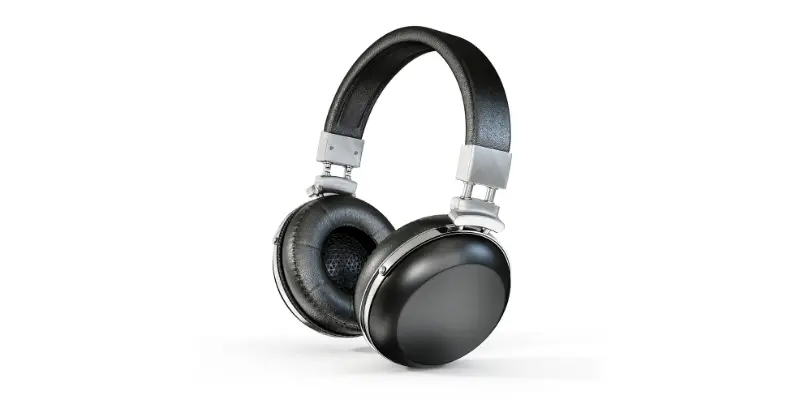Disclaimer: This post may contain affiliate links, meaning we get a small commission if you make a purchase through our links, at no cost to you. For more information, please visit our Disclaimer Page.
Some people are more sensitive to the sound of lower-quality playback equipment, including headphones. The frequency response helps people with different preferences because it determines what type of sound will be ideal for them. Manufacturers usually specify their headphones’ frequency response in hertz, indicating the range of sound frequencies reproduced by the headphone.
Ideally, a pair of headphones should be able to produce sounds in the range of 20 to 20,000 Hz. This is the average hearing range for the human ear. Meaning headphones with this range can play all the sounds a human can hear. But the frequency range alone does not determine a headphone’s quality.
Table of Contents
What is Hz?
Hertz or Hz is the unit of measurement of frequency. Typically, we use this term when we describe any sound.
Vibrations produce sound and the sound travels through these vibrations. Usually, it is the vibration that travels through the air that we hear. And the frequency of a particular sound is how often it is vibrating.
For example, let’s say a sound is about 100 Hz. This means that this particular sound is vibrating the air 100 times per second as it reaches our ears. This also means that this sound will vibrate our eardrums at that rate as well.
When our ears vibrate, the tiny hairs inside the ear will move simultaneously. If this movement is strong enough, it will generate nerve impulses that are sent to the brain. And this is how we hear sounds for the most part.
Can People Hear 5 Hz?
Generally speaking, humans cannot hear sounds as low as 5 Hz. The normal hearing range of most humans is between 20 Hz to 20,000 Hz. Anything below or above this is something that most humans will not be able to hear.
Our ears have special hairs that respond to incoming audio by vibrating, which then creates nerve signals for the brain. And these hairs are specific to certain frequencies. The hairs at the front will respond to lower frequencies and the ones at the back will respond to higher frequencies.
At 5 Hz, the sound will vibrate our eardrums 5 times per second. Meaning at this rate, the eardrums will vibrate so slowly that our brain will not receive a strong enough impulse. Meaning the 5 Hz sound will fail to generate a proper response inside our ears. So, we will not be able to hear it.
Now, this range is an average estimate that covers most humans. Some humans can hear sounds that are outside this spectrum. But in order for humans to hear lower than 20 Hz, you need to create the ideal condition, which is only possible inside a quality laboratory. And even then, 5 Hz is still too low for our ears.
Normally, our hearing only gets weaker over time due to age and environmental exposure. This can affect either our ability to hear low-frequency or high-frequency sounds. Sometimes hearing impairment can affect both sides.
How Many Hz Should Headphones Have?
Since the human hearing range is between 20-20,000 Hz, a good pair of headphones should be able to reproduce all the sound within this range. And most modern headphones do just so. If you check the specifications on the box, you will see a range of frequencies for that headphone.
As we already discussed, most humans do not have access to the full hearing range. You will normally see a decline in response at 15,000 Hz or higher. After that, the sound can get irritating. And any sound that is as low as 20 Hz will often get drowned by other sounds for you to even hear them.
Plus, most music nowadays can be between 100 to 15,000 Hz give or take. And if your headphones can play at these levels, you will hear all the sounds you want to hear.
Does Frequency Response Matter in Headphones?
The frequency response of headphones is the range of frequencies that headphones are capable of replicating. So, let’s say a headphone has a frequency response of 16 to 22,000 Hz. This means that the headphone can reproduce sound that is as low as 16 Hz and as high as 22,000 Hz.
You will have the frequency response of a headphone detailed in the specifications of all headphones. But does this number matter in the context of sound quality?
In short, the frequency response on its own is not too important. Most headphones these days can recreate sounds that cover the human hearing range. But just because a headphone has a wide range, does not mean that it can produce all the sound at the same quality.
When describing the quality of headphones, we also need to consider how loud a particular frequency sounds in that headphone.
For example, the bass is on the lower end of the audio spectrum, somewhere around 60 to 250 Hz. Now, any pair of headphones on the market will likely produce this range. But the loudness of bass music is pretty low. So, if your headphones cannot boost low-frequency noise, you are not going to hear the bass in the music.
This is where the frequency response graph or spectrum graph is more important than just the raw number. This graph shows how loud a pair of headphones will play sounds at every frequency. This is also called the sound signature of a headphone.
If a headphone has a flat signature, it means that any sound coming out of that headphone will have the same volume (noise level or decibels), regardless of the frequency.
Now a headphone with an elevation in the bass end (the low-frequency end), means that the headphone will generate bass music with more power. This, in turn, will let you hear the bass part more clearly. And the same goes for treble sounds (high frequency) and mid-range sounds.
Some headphones will have a bass boost. So, you can hear the bass over the other instruments. Some headphones will have a dip at 4,000 Hz. Meaning at that specific frequency, the noise coming out will not be as loud.
And all of this is reflected in the frequency response curve or graph. It will show you how loud the bass, mid-range, and treble noise will sound in your ear. Or at least, it will give you a pretty good idea of how loud each of the frequencies is going to sound. And for music listeners, this part is more important than the raw frequency range of a headphone.
Of course, the graph will only tell you part of the story. If you want to comprehend the overall performance of the headphone, there really is no substitute to testing them out yourself.
Which Frequency Is Best for Earphones?
From everything we have discussed so far, it is safe to say that the frequency your headphones or earphones are playing at is of little consequence. The key here is how well the headphones are playing the sound.
If your headphone is capable, it will generate sounds at any given frequency. But whether that will sound good to the ears or even audible will determine the headphone’s quality. So, there really is no ideal frequency for earphones or headphones.
Now, there are specific earphones or earbuds in the market that are particularly adept at playing one type of frequency. Some earphones will have a very good bass boost that will allow you to enjoy low-frequency sound pretty well. And there are other earphones that put more emphasis on the treble segment.
But headphones designed for loud bass can still play midrange and treble sounds. It might not be as good but it can still play them.
Conclusion
Music is a very subjective topic and the choice of headphones will vary depending on personal preference. If your priority is loud bass then go with a headphone that plays low frequency well. And if you want more treble then go with headphones that respond better to higher frequencies.


